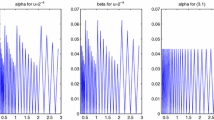Abstract
Probabilistic models of floating point and logarithmic arithmetic are constructed using assumptions with both theoretical and empirical justification. The justification of these assumptions resolves open questions in Hamming (1970) and Bustoz et al. (1979).
These models are applied to errors from sums and inner products.
A comparison is made between the error analysis properties of floating point and logarithmic computers. We conclude that the logarithmic computer has smaller error confidence intervals for roundoff errors than a floating point computer with the same computer word size and approximately the same number range.
Zusammenfassung
Unter Zugrundelegung von sowohl theoretisch als auch empirisch gerechtfertigter Annahmen wird ein stochastisches Modell der Gleitkomma- und der logarithmischen Arithmetik konstruiert. Die Rechtfertigung dieser Annahmen löst offene Fragen bei Hamming (1970) und Bustoz et al. (1979).
Diese Modelle werden auf die Fehler von Summen und inneren Produkten angewendet.
Es wird ein Vergleich zwischen den Eigenschaften von Gleitkomma- und logarithmischen Rechnern hinsichtlich ihrer Fehleranalyse angestellt. Wir kommen zu dem Schluß, daß der logarithmische Rechner kleinere Fehlerkonfidenzintervalle für die Rundungsfehler aufweist als ein Gleitkommarechner mit der gleichen Wortlänge und dem annähernd gleichen Zahlenbereich.
Similar content being viewed by others
References
Bareiss, E. H., Barlow, J. L.: Probabilistic error analysis of computer arithmetics. Northwestern University DOE Report COO-2280-37 (December 1978).
Bareiss, E. H., Grau, A. A.: Basics of the CRD computer. Northwestern University ERDA Report COO-2280-35 (August 1977).
Barlow, J. L.: Probabilistic error analysis of floating point and CRD arithmetics. Ph. D. Thesis, Northwestern University, Evanston, Illinois (June 1981 [a]).
Barlow, J. L.: On the distribution of accumulated roundoff error in floating point arithmetic. Proc. Fifth IEEE Symposium on Computer Arithmetic, Ann Arbor, Michigan (1981 [b]).
Barlow, J. L., Bareiss, E. H.: Probabilistic error analysis of Gaussian elimination in floating point and logarithmic arithmetic. Computing34, 349–364 (1985).
Benford, F.: The law of anomalous numbers. Proc. Amer. Phil. Soc.78, 551–572 (1938).
Bustoz, J., Feldstein, A., Goodman, R., Linnainmaa, S.: Improved trailing digit estimates applied to optimal computer arithmetic. JACM26, No. 4, 716–730 (1979).
Clenshaw, C. W., Olver, F. W. I.: Beyond floating point. JACM31, 319–328 (1984).
Feldstein, A., Goodman, R.: Convergence estimates for the distribution of trailing digits. JACM23, 287–297 (1976).
Flehinger, B. J.: On the probability that a random integer has initial digit A. Amer. Math. Monthly73, 105–161 (1966).
Goodman, R., Feldstein, A.: Effects of guard digits and normalization options on floating point multiplications. Computing18, 93–106 (1977).
Goodman, R., Feldstein, A.: Roundoff error in products. Computing15, 263–273 (1975).
Goodman, R., Feldstein, A.: Loss of significance in floating point subtraction and addition. IEEE Trans. on ComputersC-31 (4), 328–335 (1982).
Grau, A. A., Bareiss, E. H.: Statistical aspects of machine rounding. Northwestern University ERDA Report COO-2280-34 (August 1977).
Hamming, R. W.: On the distribution of numbers. Bell System Technical Journal49, No. 8, 1609–1625 (1970).
Hogg, R. V., Craig, A. T.: Introduction to Mathematical Statistics, Third Edition. New York: Macmillan 1970.
Knuth, D. E.: The art of computer programming, Vol. 2, Second Ed.: Seminumerical Algorithms, pp. 238–250. Reading, Mass.: Addison-Wesley 1981.
Nathan, L. H.: Probabilistic distribution of the most significant digit in computer represented numbers and its behavior under iterated fixed and floating point operations. M. S. Thesis, Northwestern University, Evanston, Illinois (August 1973).
Pinkham, R. S.: On the distribution of first significant digits. Ann. Math. Stat.32, 1223–1230 (1961).
Raimi, R. A.: On the distribution of first significant digits. Amer. Math. Monthly74, No. 2, 342–348 (1969).
Sweeney, D.: An analysis of floating point addition. IBM Systems Journal4, 31–42 (1965).
Turner, P. R.: The distribution of leading significant digits. IMA J. of Num. Anal.2, 407–412 (1982).
Turner, P. R.: Further revelations on l.s.d. IMA J. of Num. Anal.4, 225–231 (1984).
Author information
Authors and Affiliations
Additional information
Work sponsored by the National Science Foundation under contract No. MCS-790150 and under contract No. MCS-8201065. This paper is based upon the first author's Ph. D. dissertation.
Rights and permissions
About this article
Cite this article
Barlow, J.L., Bareiss, E.H. On roundoff error distributions in floating point and logarithmic arithmetic. Computing 34, 325–347 (1985). https://doi.org/10.1007/BF02251833
Received:
Revised:
Issue Date:
DOI: https://doi.org/10.1007/BF02251833




